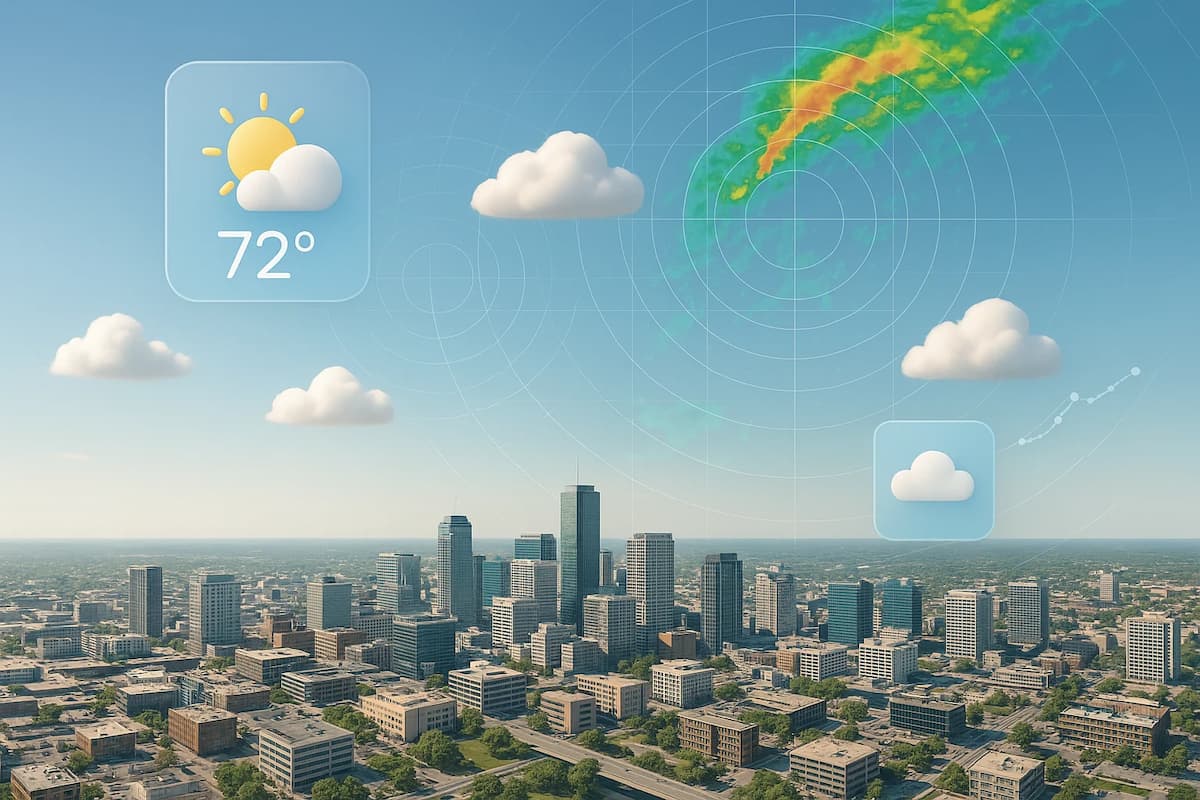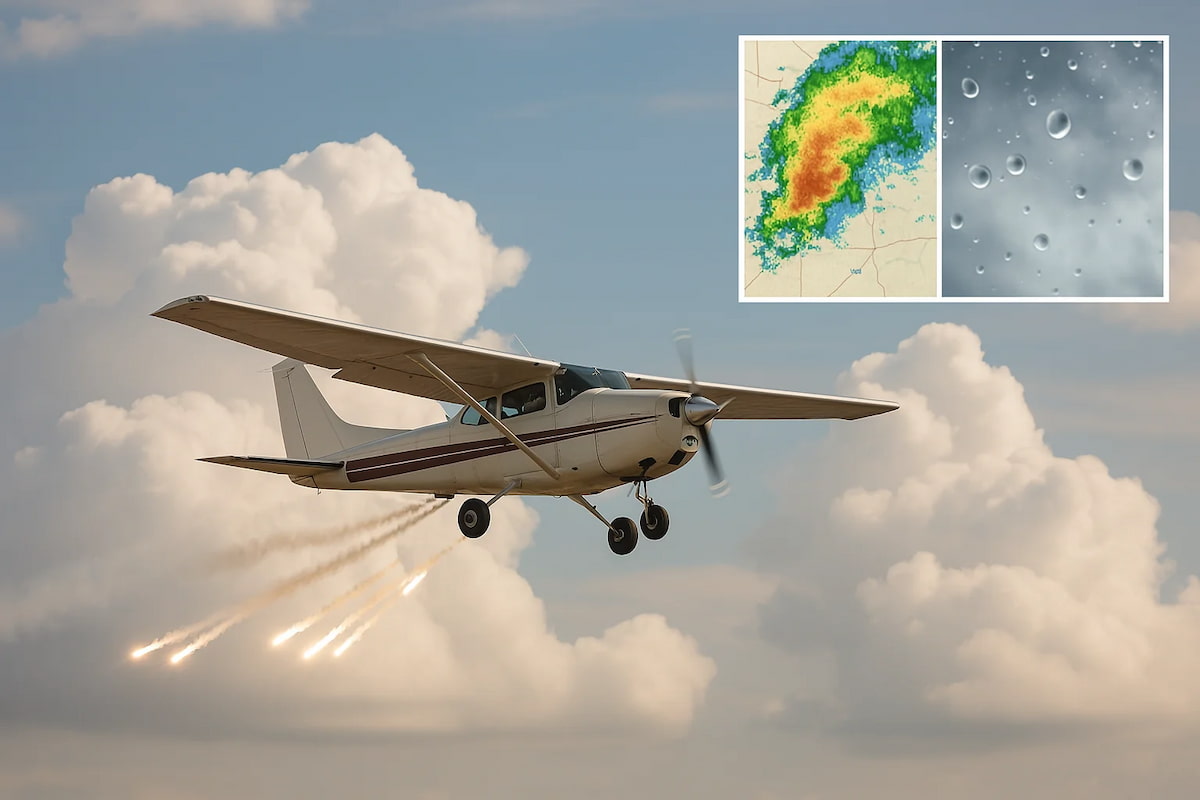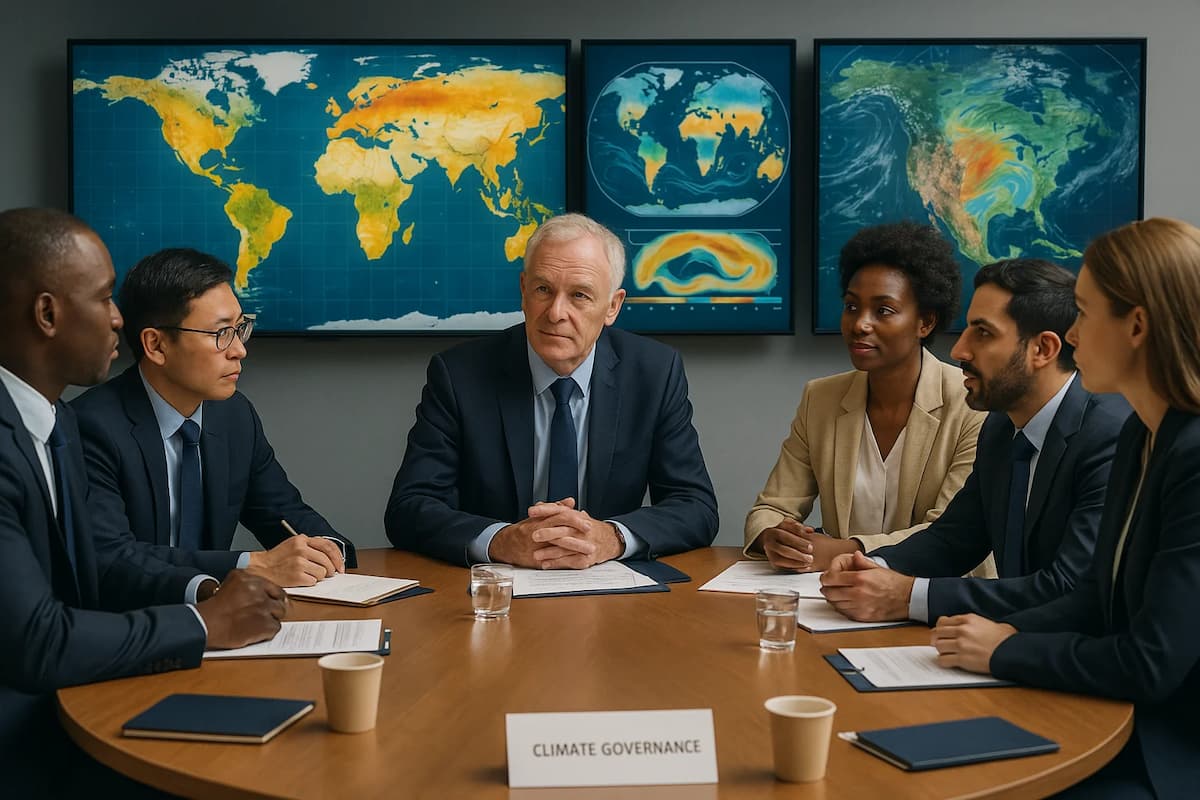
Watch short for this article (5 slides)
Playing God with the Weather? The Science, Promise, and Peril of Atmospheric Intervention
Flipping through a weather app reveals icons and numbers predicting sunshine, rain, or storms - predictions derived from complex atmospheric science. But what if we could move beyond prediction to prescription? Could humanity genuinely "order" the weather, coaxing rain from reluctant clouds or shielding cities from harsh storms? This isn't mere science fiction; technologies for weather modification and even large-scale climate intervention (geoengineering) exist and are being actively researched and, in some cases, deployed. But tampering with Earth's intricate climate system carries profound risks and ethical dilemmas. Let's explore the motivations, methods, and controversies surrounding humanity's attempts to control the skies.
Why Intervene? Motivations Behind Weather and Climate Modification
The allure of controlling weather stems from fundamental human needs and economic drivers. Historically expressed through rituals and prayers, this desire now manifests in sophisticated technological approaches aimed at:
- Agricultural Security & Water Resource Management: Augmenting rainfall in drought-stricken agricultural regions to save crops and boost yields. Increasing snowpack in mountainous regions to enhance water supply for rivers and reservoirs feeding urban and agricultural areas downstream. Global agricultural losses due to drought run into billions of dollars annually.

- Hazard Mitigation & Safety:
- Fog Dispersal: Improving visibility at airports to prevent costly delays and enhance safety. Persistent fog can shut down major airports for hours.
- Hail Suppression: Reducing the size and intensity of hailstones to protect valuable crops (fruit orchards, vineyards) and property (vehicles, roofs) from damage. Hail causes significant agricultural and property damage globally each year.
- Tropical Cyclone Modification (Highly Theoretical): Speculative ideas about weakening hurricanes or typhoons before landfall, potentially saving lives and preventing billions in damages, though methods remain unproven and highly controversial.
- Event Management & Pollution Control: Attempting to ensure clear skies for major outdoor events (like the Olympics) or induce rain to wash pollutants or dust out of the air in heavily polluted cities.
- Climate Change Counteraction (Geoengineering): Proposing large-scale interventions to counteract global warming by, for example, reflecting more sunlight away from Earth.
While the potential benefits seem compelling, the atmosphere is a complex, interconnected system. Interventions can have unintended consequences, raising significant scientific, ethical, and geopolitical questions.
Targeted Interventions: Weather Modification Techniques
Weather modification typically refers to smaller-scale efforts aimed at influencing local weather phenomena over limited time periods.
Cloud Seeding: The Most Common Technique
- Mechanism: Clouds form when water vapor condenses onto tiny airborne particles called condensation nuclei (like dust or salt). Cloud seeding introduces artificial nuclei to enhance precipitation formation.
- Cold Clouds (Below 0°C / 32°F): The most common method uses agents like silver iodide (AgI) or frozen carbon dioxide (dry ice). AgI has a crystalline structure similar to ice, acting as an effective ice nucleus, promoting the formation of ice crystals which then grow large enough to fall as snow or rain (if they melt). Dry ice pellets dropped into clouds rapidly cool the surrounding air to below -40°C, causing supercooled water droplets to freeze spontaneously (homogeneous nucleation).
- Warm Clouds (Above 0°C / 32°F): Hygroscopic seeding uses materials like salt (e.g., potassium chloride, calcium chloride) that attract water vapor, encouraging smaller cloud droplets to coalesce into larger, heavier raindrops.
- Delivery Methods: Seeding agents are typically dispersed by aircraft flying into or near target clouds (using wing-mounted flares or dropping payloads) or released from ground-based generators, relying on wind currents to carry them into the clouds.

- Effectiveness Debate: Quantifying the success of cloud seeding is notoriously difficult due to the natural variability of precipitation. While proponents and some studies suggest potential increases in precipitation (often cited in the 10-15% range for specific projects), conclusive proof remains elusive and results vary significantly depending on cloud type, atmospheric conditions, and seeding methodology. Major research efforts (like the Wyoming Weather Modification Pilot Project) have yielded ambiguous results, highlighting the scientific uncertainty. The World Meteorological Organization (WMO) acknowledges potential benefits but stresses the need for rigorous scientific validation (Source: WMO - Weather Modification).
- Concerns:
- Environmental Impact: Concerns exist about the long-term accumulation of silver iodide in soil and water, although most studies suggest concentrations remain low and below toxicity thresholds. Ecological impacts are still studied.
- Downwind Effects ("Rain Stealing"): A major concern is whether enhancing precipitation in one area deprives downwind regions of potential rainfall, raising ethical and legal issues, particularly across borders. Evidence for significant downwind depletion is generally limited but remains a point of contention.
- Cost-Benefit Analysis: The cost of operations versus the uncertain gains in precipitation requires careful evaluation.
Other Localized Techniques
- Fog Dispersal: Used primarily at airports, techniques involve seeding with dry ice or hygroscopic materials, or using heating systems or large fans to mix warmer, drier air into the fog layer.
- Hail Suppression: Aims to increase the number of ice nuclei in developing storm clouds, theoretically promoting the formation of many small, soft hailstones instead of fewer large, damaging ones. Often uses silver iodide delivered by rockets or aircraft. Effectiveness is highly debated among atmospheric scientists.
The Grand Scale: Geoengineering Concepts
Geoengineering (or climate engineering) refers to deliberate, large-scale manipulation of the Earth's climate system, primarily intended to counteract anthropogenic climate change. It's generally divided into two main categories:
Solar Radiation Management (SRM)
SRM aims to cool the planet by reflecting a small fraction of incoming sunlight back into space. Proposed methods include:
- Stratospheric Aerosol Injection (SAI): Injecting reflective aerosol particles (e.g., sulfur dioxide, which forms sulfate aerosols) into the stratosphere (around 20 km / 12 miles altitude) to mimic the cooling effect of large volcanic eruptions (like Mount Pinatubo in 1991, which caused temporary global cooling of about 0.5°C). This is the most studied SRM method.
- Marine Cloud Brightening (MCB): Spraying fine sea salt aerosols into low-lying marine clouds to increase the number of cloud droplets, making the clouds brighter and more reflective.
- Surface Albedo Modification: Increasing the reflectivity of Earth's surface (e.g., using reflective materials on roofs, deserts, or oceans).

Profound Risks and Concerns of SRM:
"SRM represents a set of technologies with potentially catastrophic risks, including irreversible impacts on regional climates and ecosystems, while failing to address the root cause of climate change (greenhouse gas emissions) or its direct consequences like ocean acidification." - Summary of concerns from major scientific bodies like the IPCC and National Academies. (Source: IPCC AR6 WG1 Ch4 - context on SRM uncertainties; Source: US National Academies Report on Solar Geoengineering)
- Termination Shock: If SRM deployment were started and then suddenly stopped (due to technical failure, political conflict, etc.), global temperatures could rebound extremely rapidly, potentially faster than ecosystems or human societies could adapt.
- Altered Weather Patterns: Models suggest SRM could significantly disrupt global precipitation patterns, potentially weakening vital monsoon systems in Asia and Africa, leading to severe droughts affecting billions of people.
- Ozone Layer Damage: Stratospheric aerosols could exacerbate ozone depletion, particularly over the poles.
- Doesn't Stop Ocean Acidification: SRM only masks the warming effect of CO₂; it does nothing to reduce atmospheric CO₂ concentrations or halt ocean acidification.
- Governance and Geopolitical Chaos: Who would control a global thermostat? Unilateral deployment by one nation could trigger international conflict. The potential for weaponization is immense. There is currently no international framework to govern SRM research or deployment.
- Moral Hazard: The prospect of a "techno-fix" might reduce the incentive to cut greenhouse gas emissions, the only sustainable long-term solution.
Carbon Dioxide Removal (CDR) / Greenhouse Gas Removal (GGR)
CDR aims to remove CO₂ directly from the atmosphere and store it durably. Methods include:
- Afforestation/Reforestation: Planting trees to absorb CO₂.
- Direct Air Carbon Capture and Storage (DACCS): Using chemical processes to capture CO₂ directly from ambient air, then storing it underground or using it.
- Bioenergy with Carbon Capture and Storage (BECCS): Burning biomass for energy, capturing the resulting CO₂, and storing it.
- Enhanced Weathering: Spreading crushed silicate rocks on land or oceans to accelerate natural chemical weathering processes that consume CO₂.
- Ocean Fertilization/Alkalinization: Adding nutrients (like iron) or alkaline substances to the ocean to stimulate phytoplankton growth (consuming CO₂) or enhance the ocean's CO₂ uptake capacity (risks ecosystem disruption).
CDR Status: Generally considered less ethically fraught than SRM, as it addresses the root cause (CO₂). However, current CDR methods face significant challenges regarding cost, scalability, energy requirements, permanence of storage, and potential environmental side effects (e.g., land/water use conflicts). Most climate scenarios aiming for 1.5°C or 2°C rely on large-scale CDR deployment later this century, alongside rapid emissions reductions (Source: IPCC AR6 WG3 Ch12 - CDR methods and potentials).
Real-World Attempts and Ambitions
- China: Operates the world's largest weather modification program, primarily using cloud seeding for drought relief, hail suppression, and attempting rain/smog reduction in major cities. Its claimed successes are extensive, though independent verification remains challenging. They also attempted weather clearing for the 2008 Beijing Olympics.
- United Arab Emirates (UAE): Invests heavily in rain enhancement science, using sophisticated aircraft, radar systems, and novel seeding techniques (including using drones to deliver electrical charges into clouds) to boost rainfall in the arid region.
- United States: Cloud seeding programs have operated for decades, particularly in western states (e.g., Colorado, California, Wyoming), aiming to increase snowpack for water supply, supported by state and local water agencies.
The Gordian Knot: Ethics, Geopolitics, and Governance
Intentional weather and climate modification raises profound ethical and governance challenges:
- Sovereignty and Transboundary Harm: Does one nation have the right to modify weather that might affect its neighbors? How can "weather theft" or downwind impacts be proven and adjudicated?
- Decision-Making Authority: Who decides whether, when, and how to deploy these technologies, especially potentially world-altering SRM?
- Equity and Justice: Who benefits from these interventions, and who bears the risks? Developing nations are often most vulnerable to climate change impacts but may also be most vulnerable to unintended consequences of geoengineering deployed by richer nations.
- Lack of Regulation: While the 1978 Environmental Modification Convention (ENMOD) prohibits the hostile use of weather modification techniques, there is no comprehensive international framework governing research or deployment for peaceful purposes, especially for SRM.
- Transparency and Public Consent: Decisions about potentially planet-altering technologies require broad public understanding and debate, which is currently lacking.

The Collective Responsibility: Reducing the Need for Risky Interventions
While individuals cannot directly control national weather modification programs or geoengineering research, collective action to address the root cause of climate instability - greenhouse gas emissions - is paramount. Reducing our carbon footprint lessens the environmental pressures that might drive nations toward potentially dangerous technological fixes.
- Advocate for and Adopt Clean Energy: Support policies promoting renewable energy (solar, wind) and transition away from fossil fuels. Reduce personal energy consumption through efficiency measures (insulation, LED lighting, energy-star appliances).
- Embrace Sustainable Transportation: Prioritize walking, cycling, public transit, and electric vehicles where feasible. Reduce air travel when possible.
- Support Nature-Based Solutions: Advocate for protecting and restoring forests, wetlands, and other ecosystems that naturally regulate climate and sequester carbon. Participate in local tree-planting initiatives.
- Promote Sustainable Consumption: Reduce waste, consume less meat (especially beef), choose products with lower environmental footprints, and support circular economy principles.
- Stay Informed and Engage: Learn about climate science and policy. Engage in public discourse and hold elected officials accountable for ambitious climate action. Support international cooperation and transparency regarding weather/climate modification research.
By stabilizing the climate through proven, sustainable means, we diminish the perceived necessity for high-risk, unpredictable interventions in the Earth's complex atmospheric systems.
Conclusion: Caution in the Face of Complexity
Humanity's ability to influence weather and climate has moved from ancient hope to technological reality. Localized weather modification like cloud seeding is practiced globally, albeit with ongoing debate about its efficacy and side effects. Large-scale geoengineering, particularly SRM, remains largely theoretical but looms as a potential high-stakes gamble fraught with catastrophic risks and ethical nightmares.
While the allure of controlling the elements is strong, especially in the face of growing climate impacts, profound caution is warranted. The Earth's climate system is interconnected in ways we don't fully understand, and large-scale interventions could trigger irreversible and devastating consequences. The most responsible path remains unequivocally focused on rapid and deep reductions in greenhouse gas emissions, coupled with adaptation to unavoidable climate changes. Tinkering with the atmosphere should not be seen as a substitute for addressing the problems we have created at their source.